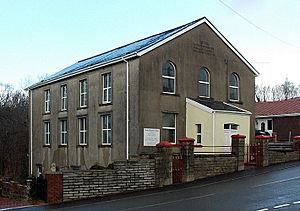Bethel Chapel, Abernant facts for kids
Quick facts for kids Bethel, Abernant |
|
|---|---|

Bethel Chapel
|
|
| 51°43′17.6160″N 3°25′47.3160″W / 51.721560000°N 3.429810000°W | |
| Denomination | Baptist |
| History | |
| Status | Active |
| Founded | 1846 |
| Architecture | |
| Style | Simple Round-headed |
| Years built | 1856–1895 |
| Completed | 1895 (replacing earlier building) |
| Construction cost | £344 (1856) |
Bethel Chapel in Abernant, Wales, is a historic Baptist church. It is special because it is one of the few older chapels in its area that is still open today.
The Start of Bethel Chapel
Bethel Chapel began as a Sunday School in 1846. It was a branch of another church called Calfaria, Aberdare. The Sunday School was looked after by Reverend John Thomas.
The church itself was officially started in 1857. A very important person in this was Thomas Price. He was the minister of Calfaria, Aberdare, and a leading figure for Baptists in the area.
The first schoolroom was built in 1856 and cost £344. But it quickly became too small. So, in 1861, it was taken down. A new, bigger chapel was built in its place. On May 20, 1862, people from Calfaria and other churches marched from Aberdare to Abernant. Thomas Price led this procession. They laid a special foundation stone for the new chapel.
The new building was finished very quickly, in just seven months! Opening services were held on December 7 and 8, 1862. To help Bethel grow, 163 members moved from Calfaria to join the new church. Thomas Price helped many other local chapels start by sending members from Calfaria.
Thomas Price also made sure the Baptist churches stayed connected. They held special baptism services in the Cynon River. They also had yearly eisteddfodau, which are Welsh festivals of music and poetry. People remembered seeing Dr. Price baptize many new members in the river. The community would march from the chapel to the river, singing hymns. A local ironworks owner, Richard Fothergill, even provided a special pool in the river for these baptisms.
Early Leaders and Changes
The first minister at Bethel was William Williams in 1864. He stayed for about a year before moving away. After him, T.T. Jones became minister for 18 months. During his time, he performed 159 baptisms.
T.T. Jones also made Bethel a center for learning. He gave talks about geology, which is the study of rocks and the Earth. This was very important because chapels often helped working-class people get an education before schools were common.
In 1867, Bethel was one of the first churches in the Aberdare Valley to get an indoor baptismal well. This meant people no longer had to be baptized in the river.
John Fuller-Davies was the minister from 1869 to 1872. He sadly passed away from smallpox. Many people attended his funeral. By 1873, the church had paid off the £800 debt from building the chapel.
John Mills became the minister in 1876. He had been a minister in other places before coming to Bethel. He stayed at Bethel until he passed away in 1909.
By 1880, Bethel Chapel had 240 members. The chapel was changed again in 1895. This cost £2000 and made space for 750 people to sit.
Bethel in the 1900s
In December 1912, Bethel held a week of special services. They were celebrating 50 years since the chapel building opened.
Reverend B. Williams became the minister in January 1914. That same year, 47 young men from Bethel joined the armed forces. In 1916, the church had 395 members. This number stayed steady at 398 in 1925. Reverend Williams was the minister until 1932.
After him, other ministers included Alun J. Davies (1938–1945), Emlyn Jones (1950–1956), Glyn E. Williams (1957–1959), and Idwal Wynne Owen from 1961.
The number of members started to go down over time. In 1955, there were 154 members. By 1963, there were 137. By 2004, only eight members were attending services.

